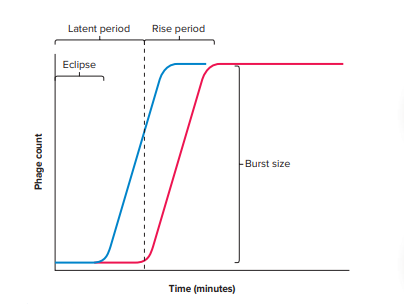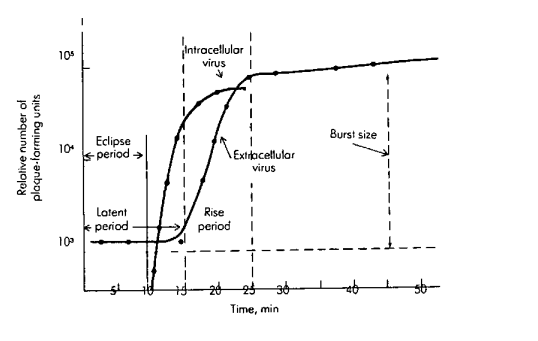One Step Growth Curve
- The One Step Growth Curve was first described by Max Delbriick and Emory Ellis in 1939 and started modern bacteriophage research.
- They also discovered the plague counting technique for the enumeration of bacteriophages.
- In one step growth experiment, only a single or one cycle of virus growth is observed, that’s why it’s termed as one step growth experiment.
- The infection is synchronous because an excess amounts of host cells are released to infect with phage particles. That means the simultaneous infection of a large number of particles to the host cell is taking place.
- The excess number of host cells are infected with phage particles at a ratio of 1:10.
- During one-step growth experiment, Max Delbriick and Emory Ellis mixed the E. coli cells with T4 phage. After a short interval, the mixture was greatly diluted so that any virions released upon host cell lysis would not encounter and infect other cells. The diluted culture was then incubated, and over time samples were removed to determine the number of infectious phage particles in the culture.
- The number of phage particles released from bacteria is subsequently determined at different time intervals by using a plaque assay method.
- A plot of the number of phase particles versus time shows several distinct periods in the resulting growth curve. The latent period occurs immediately following the addition of the phages. During this period, no virions are released.
- The rising period follows and is characterized by the rapid release of infective phages. Finally, a plateau is reached and no more virions are produced.
- When a log no, of plague forming units/ml is plotted against time, a curve is obtained & it is known as one step growth curve.

Phases of One Step Growth Curve
The One Step Growth Curve consists of two periods such as Latent Period, and the Rise Period.
Latent Period
- This period immediately follows from the infection of viruses into the host to cell lysis.
- It is considered the shortest period required for virus reproduction and release.
- During this period of one step growth curve, no new virus particles are released from the infected cells.
- The plaque count of this period is constant.
- The latent period of the T phage can last for 22 to 23 min at 37°C.
- The Latent Period is classified into two phases such as ‘Eclipse’ period & ‘Intracellular Accumulation’ period.
- Time from infection until intracellular accumulation of phages is known as the ‘Eclipse’ period. The time length of the eclipse period within the bacteriophage is about 11.5 min at 37°C. During this period the gene expression, protein synthesis & genome synthesis occurs.
- The eclipse period is the initial portion of the latent period in which host cells do not contain any complete, infectious virions. During the remainder of the latent period, an increasing number of infectious virions are present, but none are released.
- The ‘Intracellular Accumulation’ period ranges from the initiation to the end of intracellular accumulation of phages. In this period the phage proteins & genomes assemble into new phage particles. The ‘Intracellular Accumulation’ period lasts 11 to 12 min at 37° C within the T2 bacteriophage.
Rise Period or Burst Period
- The Rise Period or Burst Period began after the latent period when the host cells rapidly lyse and release all infective phages.
- In this period the new viral particles are released from the infected cells & therefore, plaque count increases rapidly.
- The rise period lasts 10 min. at 37°C within the T2 bacteriophage.
- This period is slightly extended due to the asynchrony of infection.
- At the end, no more viruses are liberated.
- The number of bacteriophages released from the infected cells can be used to calculate the burst size.

Plateau Period
- There is another period within the one step growth curve known as the Plateau Period. This period represents the end of all infected host cell lysis.
- In this period the newly liberated phage particles can’t enter into the uninfected host cells due to high dilution. Therefore, the plaque count remains constant.
- T2 phage enters the plateau in about 30 min. at 37°C.
Application of One step growth curve
- It employed procedures that are still used today to culture and enumerate viruses, and it ushered in the modern era of phage biology.
- Used to construct the growth curve of phage from laboratory data and determine its burst size.
- To identify the phases of a phage growth curve.
- To define the events involved in phage: bacterium interaction resulting in phage replication and release.
- One Step Growth Curve reveals the fundamental nature of the virus replication process.
What is Burst Size?
Burst size is defined as the number of virus particles produced from the infection of a single cell. In T2 phage the burst size is less than 100 phages/cell. The Burst size may vary from 20 to 3000 virions/cell based on types of viruses.The burst size is calculated using following formula –

References
- Prescott’s Microbiology by Joanne Willey, Linda Sherwood, Christopher J. Woolverton
- Microbiology by Michael Joseph Pelczar
- https://www.biotechfront.com/2021/06/one-step-growth-curve-experiment-of.html
- https://www.biologydiscussion.com/viruses/growth-curve-of-bacteriophage/47107
- https://www.sas.upenn.edu/LabManuals/biol275/Table_of_Contents_files/13-PhageGrowth.pdf
- Text Highlighting: Select any text in the post content to highlight it
- Text Annotation: Select text and add comments with annotations
- Comment Management: Edit or delete your own comments
- Highlight Management: Remove your own highlights
How to use: Simply select any text in the post content above, and you'll see annotation options. Login here or create an account to get started.